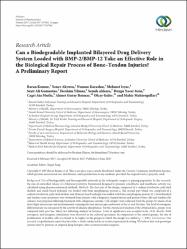| dc.contributor.author | Kömür, Baran | |
| dc.contributor.author | Akyuva, Yener | |
| dc.contributor.author | Karaslan, Numan | |
| dc.contributor.author | İşyar, Mehmet | |
| dc.contributor.author | Gümüştaş, Seyit Ali | |
| dc.contributor.author | Yılmaz, İbrahim | |
| dc.contributor.author | Akkaya, Semih | |
| dc.contributor.author | Şirin, Duygu Yaşar | |
| dc.contributor.author | Mutlu, Çağri Ata | |
| dc.contributor.author | Batmaz, Ahmet Güray | |
| dc.contributor.author | Güler, Olcay | |
| dc.contributor.author | Mahiroğulları, Mahir | |
| dc.date.accessioned | 10.07.201910:49:13 | |
| dc.date.accessioned | 2019-07-10T20:01:27Z | |
| dc.date.available | 10.07.201910:49:13 | |
| dc.date.available | 2019-07-10T20:01:27Z | |
| dc.date.issued | 2017 | en_US |
| dc.identifier.citation | Kömür, B., Akyuva, Y., Karaslan, N., İşyar, M., Gümüştaş, S. A., Yılmaz, İ. ... Mahiroğulları, M. (2017). Can a biodegradable implanted bilayered drug delivery system loaded with BMP-2/BMP-12 take an effective role in the biological repair process of bone-tendon injuries? A preliminary report. Journal of Pharmaceutics, 2017. https://dx.doi.org/10.1155/2017/7457865 | en_Us |
| dc.identifier.issn | 2090-9918 | |
| dc.identifier.issn | 2090-7818 | |
| dc.identifier.uri | https://dx.doi.org/10.1155/2017/7457865 | |
| dc.identifier.uri | https://hdl.handle.net/20.500.12511/3281 | |
| dc.description | WOS: 000402656700001 | en_US |
| dc.description.abstract | Background. Use of biodegradable and biocompatible materials in the orthopedic surgery is gaining popularity. In this research, the rate of controlled release of a bilayered prototype biomaterial designed to promote osteoblastic and tenoblastic activity was calculated using pharmacochemical methods. Methods. The first part of the design, composed of a sodium tetraborate, polyvinyl alcohol, and starch based hydrogel, was loaded with bone morphogenic protein-2. The second part which was composed of a sodium tetraborate, polyvinyl alcohol, and chitosan based hydrogel was loaded with bone morphogenic protein-12. Osteochondral and tendon tissue specimens were obtained from patients with a diagnosis of gonarthrosis and primary bone cells and tendon cells cultures were prepared following treatment with collagenase enzyme. Cell samples were collected from the groups by means of an invert light microscope and environmental scanning electron microscope underwent at the 1st and 21st days. Thelevel of osteogenic differentiation was measured by the activity of alkaline phosphatase. For the statistical evaluation of the obtained data, groups were compared with post hoc Tukey test following analysis of variance. Level of significance was accepted to be <0,01. Results. Both osteogenic and tenogenic stimulation were observed in the cultured specimens. In comparison to the control groups, the rate of proliferation of healthy cells was found to be higher in the groups to which the design was added (P < 0.01). Conclusions. Our research is a preliminary report that describes a study conducted in an in vitro experimental setting. We believe that such prototype systems may be pioneers in targeted drug therapies after reconstructional surgeries. | en_US |
| dc.language.iso | eng | en_US |
| dc.publisher | Hindawi Ltd | en_US |
| dc.rights | info:eu-repo/semantics/openAccess | en_US |
| dc.subject | Biodegradable Implanted | en_US |
| dc.subject | Bilayered Drug Delivery System | en_US |
| dc.subject | BMP-2/BMP-12 | en_US |
| dc.subject | Biological Repair Process | en_US |
| dc.subject | Bone-Tendon Injuries | en_US |
| dc.title | Can a biodegradable implanted bilayered drug delivery system loaded with BMP-2/BMP-12 take an effective role in the biological repair process of bone-tendon injuries? A preliminary report | en_US |
| dc.type | article | en_US |
| dc.relation.ispartof | Journal of Pharmaceutics | en_US |
| dc.department | İstanbul Medipol Üniversitesi, Tıp Fakültesi, Dahili Tıp Bilimleri Bölümü, Tıbbi Farmakoloji Ana Bilim Dalı | en_US |
| dc.authorid | 0000-0003-2003-6337 | en_US |
| dc.identifier.volume | 2017 | en_US |
| dc.relation.publicationcategory | Makale - Uluslararası Hakemli Dergi - Kurum Öğretim Elemanı | en_US |
| dc.identifier.doi | 10.1155/2017/7457865 | en_US |


















